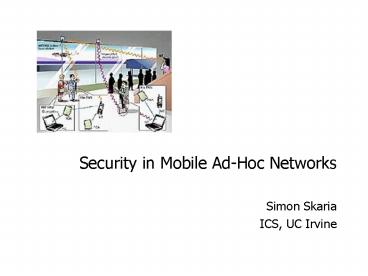Security in Mobile AdHoc Networks - PowerPoint PPT Presentation
1 / 21
Title:
Security in Mobile AdHoc Networks
Description:
Securing Ad-Hoc Networks. Need to provide 'Anywhere, Anytime' security services ... Dynamic wireless ad-hoc network with N networking hosts/entities ... – PowerPoint PPT presentation
Number of Views:85
Avg rating:3.0/5.0
Title: Security in Mobile AdHoc Networks
1
- Security in Mobile Ad-Hoc Networks
- Simon Skaria
- ICS, UC Irvine
2
What is Ad-Hoc?
- No infrastructure required
- Like Bluetooth, IR Unlike 802.11
- Each node can communicate with another node if
- within the radio range, or
- a pager node is available
3
Securing Ad-Hoc Networks
- Need to provide Anywhere, Anytime security
services - Dynamically changing network topologies
- Resource constrained units, normally
- Jittery channel, Easy to jam and intrude
4
Authentication in Ad-Hoc Networks
- Uses Certificate-Based approach
- Intrusion Resistant, not intrusion Free
- Distributes CA functionality in each neighborhood
- Self-Initialization protocol to handle dynamic
node membership
5
Network Setting
- Dynamic wireless ad-hoc network with N networking
hosts/entities - Every entity i has a globally unique nonzero ID
vi - Entities roam freely in the network
- Number of entities, N may change over time
6
Security Assumption
- Scheme assumes one of the following
- An entitys private key will not be exposed for a
certain period of time, OR - An entitys ID, vi is not forgeable by the
intruder
7
Locally Distributing CAs
- SK, PK denote the RSA Key pair of the System CA
- Secret is distributed using Shamirs scheme
- Each entity vi holds a secret share Pvi and any K
of such entities can collectively function the
role of a CA
8
Individually,
- Maintains a public key pair
- Signed by CA (SK), contains Tsign, Texpire
- Used for
- Cipher-Key Exchange
- Message Privacy
- Message Integrity and
- Non-Repudiation
9
Enforcing Validity
- Implicit Certificate Revocation
- Certificate is considered invalid unless renewed
within Trenew - Explicit Certificate Revocation
- CRL of revoked certificates is maintained.
- An entry needs to be kept for Trenew amount of
time
10
Basic Operations
- Involves local coalition of K share holders
- Secret Share Dealing
- Certification Services, and
- Secret Share Updates
11
Secret Share Dealing
- An entity vi obtains its secret share Pvi
- Bootstrapping phase
- Before K entities have joined the group
- Self-Initialisation phase
- Need a local coalition of K entities
- Centralized dealer is not needed any more
12
Certification Services
13
Secret Share Updates
- No adversary group having less than K
collaborative adversaries can forge a certificate - To resist gradual break-ins, secret share is
updated periodically - Update time is a system parameter
14
Certificate Revocation
- Over and above the implicit revocation scheme
- If vxs certificate is compromised, a counter
certificate lt?vx , Tsign? gt is flooded over the
network - Each node maintain a subset of
counter-certificates within the past Trenew
15
Shamirs Secret Sharing
- D is secret to be shared
- Lagrange polynomial
- F(x) D f1.x fk-1.xk-1
- fis Chosen randomly
- Each entity holds a secret share
- Pvi (f(vi) mod n)
16
Localized Certification Service
17
Interpolation over Z?(n) Problem!
- (Pvi .lvi(0) mod n) t.n d 0?t?K
- X ? Xd mod n
18
Solution Coalition Offsetting
- Y0, Product of the Signatures Received
- Z M-n mod n
- j 0 w 1
- while j ? K do
- Y Y0.W mod n W W.Z mod n
- if (M ? Ye (mod n)) then break
- j j 1
19
Self-Initialization
20
Self-Initialization, in Practice
- Uninitialized node vx broadcasts request
- Each member selects a random nonce
- ID forms a partial order
- Encrypts with of the intended receiver
- The requester routes encrypted nonces
- Nonces are added to the partial secret share
21
Issues
- Padding used in RSA do not cancel each other
- Secret Share of a new entity in the
self-initialization process - How do you know the K-participating entities in
Self-Initialization? - K is not flexible




























![[AD Hoc Networks] PowerPoint PPT Presentation](https://s3.amazonaws.com/images.powershow.com/8371435.th0.jpg?_=20161231113)


